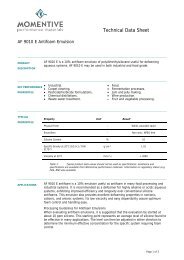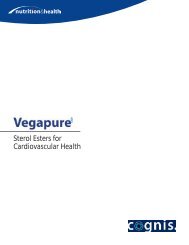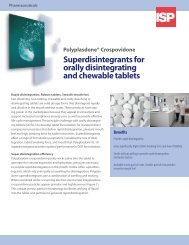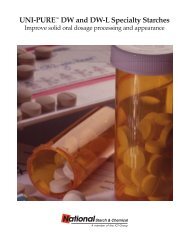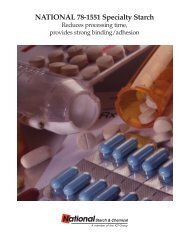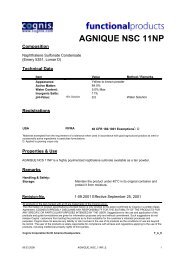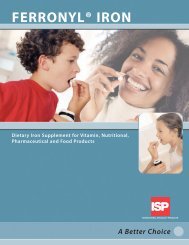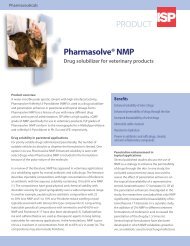Nonionic superdisintegrant for improved dissolution of cationic drugs
Nonionic superdisintegrant for improved dissolution of cationic drugs
Nonionic superdisintegrant for improved dissolution of cationic drugs
You also want an ePaper? Increase the reach of your titles
YUMPU automatically turns print PDFs into web optimized ePapers that Google loves.
INTER<br />
Pharmaceuticals<br />
Polyplasdone® Crospovidone<br />
<strong>Nonionic</strong> <strong>superdisintegrant</strong><br />
<strong>for</strong> <strong>improved</strong> <strong>dissolution</strong> <strong>of</strong><br />
<strong>cationic</strong> <strong>drugs</strong><br />
The superior <strong>dissolution</strong> per<strong>for</strong>mance<br />
<strong>of</strong> Polyplasdone® crospovidone<br />
The <strong>dissolution</strong> rate <strong>of</strong> a drug plays an important role in its bioavailability.<br />
Thus, it is frequently necessary to <strong>for</strong>mulate with a disintegrant that<br />
produces the fastest rate <strong>of</strong> drug <strong>dissolution</strong>. When working with<br />
<strong>cationic</strong> <strong>drugs</strong>, however, anionic disintegrants like croscarmellose sodium<br />
(CCS) and sodium starch glycolate (SSG) may interact with the active and<br />
actually retard <strong>dissolution</strong>. Unlike anionic disintegrants, Polyplasdone<br />
crospovidones are nonionic and will not complex with <strong>cationic</strong> drug<br />
actives to delay drug <strong>dissolution</strong>.<br />
Chemically inert. And other reasons why<br />
Polyplasdone crospovidone is better<br />
Polyplasdone crospovidone is nonionic (Figure 1). Other <strong>superdisintegrant</strong>s<br />
such as CCS and SSG are anionic in nature (Figures 2 and 3).<br />
It has been proposed that any weakly basic (<strong>cationic</strong>) drug, when<br />
present in an environment where the pH is >2 and near or below the<br />
pKa <strong>of</strong> the <strong>cationic</strong> drug, should be expected to interact with ionized<br />
polymers like CCS and SSG (1). Thus, it is not surprising that with eight<br />
<strong>of</strong> eight <strong>cationic</strong> drug actives evaluated, tablets with Polyplasdone<br />
crospovidone provided the fastest rate <strong>of</strong> <strong>dissolution</strong> compared to<br />
tablets with CCS and SSG.<br />
Figure 1: Chemical structure <strong>of</strong> Polyplasdone crospovidone<br />
Benefits<br />
<strong>Nonionic</strong> - will not interact with <strong>cationic</strong> drug actives<br />
Superior <strong>dissolution</strong> per<strong>for</strong>mance with both soluble and poorly<br />
soluble <strong>cationic</strong> actives<br />
Compatible with most pharmaceutical <strong>for</strong>mulation ingredients<br />
Available as free-flowing, white powders in a range <strong>of</strong> particle sizes<br />
Figure 2: Croscarmellose sodium structure<br />
O<br />
CH 2OCH 2COONa<br />
O<br />
OH<br />
OH<br />
O<br />
OH<br />
OH<br />
O<br />
O<br />
CH 2OCH 2COONa<br />
n<br />
CH 2<br />
CH n<br />
N O<br />
Figure 3: Sodium starch glycolate structure<br />
CH2COONa<br />
CH2OH<br />
CH2OH<br />
CH2OH<br />
O<br />
O<br />
O<br />
OH<br />
OH<br />
OH<br />
O<br />
O<br />
O<br />
OH<br />
OH<br />
OH<br />
n
Pharmaceuticals<br />
Not all disintegrants per<strong>for</strong>m the same with <strong>cationic</strong> <strong>drugs</strong><br />
To directly compare the effect <strong>of</strong> disintegrants on the rate <strong>of</strong> drug<br />
<strong>dissolution</strong>, Polyplasdone XL and XL-10 crospovidones, CCS and<br />
and SSG were evaluated at 2% w/w according to the model tablet<br />
<strong>for</strong>mulation listed in Table 1. To compare disintegrant per<strong>for</strong>mance,<br />
the drug active level and those <strong>of</strong> the other excipients<br />
were held constant. For a given drug studied, all <strong>of</strong> the tablets<br />
with the various <strong>superdisintegrant</strong>s studied were compressed to<br />
equal breaking <strong>for</strong>ce and exhibited similar disintegration properties.<br />
Both soluble and poorly soluble <strong>drugs</strong> were selected (Table<br />
2) to determine if the observed trend differed based on drug<br />
solubility. For the <strong>dissolution</strong> media, the media recommended<br />
by the United States Pharmacopeia (USP) or by the U.S. Food and<br />
Drug Administration (FDA) <strong>for</strong> each drug was used.<br />
Table 1: Direct compression tablet <strong>for</strong>mulation<br />
Ingredient Amount (%) Amount (mg)<br />
Drug Active 18.0 99.0<br />
Disintegrant 2.0 11.0<br />
Talc 0.5 2.75<br />
Magnesium Stearate 0.5 2.75<br />
Microcrystaline Cellulose 79.0 434.5<br />
Total 100.0 550.0<br />
The time required to achieve 80% drug release <strong>for</strong> all <strong>drugs</strong><br />
studied with each <strong>superdisintegrant</strong> in the recommended media<br />
is shown in Table 3. With all eight <strong>cationic</strong> <strong>drugs</strong> tested, tablets<br />
containing Polyplasdone disintegrants provided the fastest drug<br />
release compared to the other disintegrants. By comparison,<br />
the anionic disintegrants – CCS and SSG – imparted the slowest<br />
rate <strong>of</strong> drug release with <strong>cationic</strong> actives. The <strong>dissolution</strong> pr<strong>of</strong>iles<br />
are shown in Figures 4 through 11. Thus, when <strong>for</strong>mulating with<br />
<strong>cationic</strong> <strong>drugs</strong>, Polyplasdone crospovidones are the preferred<br />
disintegrants – continued pro<strong>of</strong> that the technology is a problem<br />
solver <strong>for</strong> <strong>for</strong>mulators <strong>of</strong> oral solid dosage <strong>for</strong>ms.<br />
Figure 4: Polyplasdone disintegrants provided the fastest tablet<br />
<strong>dissolution</strong> with venlafaxine HCI<br />
Tablet breaking <strong>for</strong>ce = 178 N + /- 5%<br />
The <strong>dissolution</strong> medium is water as specified by U.S. FDA,<br />
Dissolution Methods <strong>for</strong> Drug Products<br />
% Drug Dissolved<br />
100<br />
80<br />
60<br />
40<br />
20<br />
Table 2: Cationic drug actives evaluated<br />
0<br />
0<br />
10<br />
20<br />
30<br />
40<br />
50<br />
60<br />
Time (in minutes)<br />
Active<br />
Aqueous Solubility*<br />
Polyplasdone XL<br />
Polyplasdone XL-10<br />
Croscarmellose Sodium<br />
Sodium Starch Glycolate<br />
Chlorpromazine HCl<br />
Ranitidine HCl<br />
Cetirizine HCl<br />
Venlafaxine HCl<br />
Cipr<strong>of</strong>loxacin HCl<br />
Freely Soluble<br />
Freely Soluble<br />
Freely Soluble<br />
Freely Soluble<br />
Slightly Soluble<br />
Figure 5: Polyplasdone XL provides the fastest<br />
<strong>dissolution</strong> with cipr<strong>of</strong>loxacin HCI<br />
Tablet breaking <strong>for</strong>ce = 184 N + /- 5%<br />
The <strong>dissolution</strong> medium is 0.1N HCI as specified by USP<br />
100<br />
Fex<strong>of</strong>enadine HCl<br />
Slightly Soluble<br />
80<br />
Terbinafine HCI<br />
Clopidogrel Bisulfate<br />
Slightly Soluble<br />
Practically Insoluble<br />
% Drug Dissolved<br />
60<br />
40<br />
* The aqueous solubility <strong>of</strong> each drug is based on definitions <strong>for</strong> solubility<br />
provided in the European Pharmacopeia. Freely soluble is defined as a<br />
compound requiring 1 to 10 ml <strong>of</strong> water to dissolve 1 gram <strong>of</strong> drug at<br />
15-25ºC. A soluble compound requires 10 to 30 ml <strong>of</strong> water to dissolve 1<br />
gram <strong>of</strong> drug. Slightly soluble and very slightly soluble require 100-1,000<br />
ml and 1,000-10,000 ml <strong>of</strong> water to dissolve a gram <strong>of</strong> drug, respectively. A<br />
practically insoluble compound requires more than 10,000 ml <strong>of</strong> water to<br />
dissolve 1 gram <strong>of</strong> drug.<br />
20<br />
0<br />
0<br />
Polyplasdone XL<br />
10 20 30 40 50 60<br />
Time (in minutes)<br />
Polyplasdone XL-10 Croscarmellose Sodium Sodium Starch Glycolate
Pharmaceuticals<br />
Table 3: Polyplasdone crospovidone shows the fastest drug release with <strong>cationic</strong> drug actives<br />
Drug<br />
Dissolution<br />
Media<br />
Polyplasdone XL<br />
Polyplasdone<br />
XL-10<br />
T 80 (minutes)<br />
Croscarmellose<br />
Sodium<br />
Starch Glycolate<br />
Sodium<br />
Chlorpromazine HCl 0.1 N HCl 25 29 33 42<br />
Ranitidine HCl water 8 21 34 38<br />
Cetirizine HCl water 13 15 59 24<br />
Venlafaxine HCl water 7 6 21 10<br />
Cipr<strong>of</strong>loxacin HCl 0.1N HCl 21 27 33 25<br />
Fex<strong>of</strong>enadine HCl 0.001 N HCl 14 24 29 24<br />
Terbinafine HCl<br />
Clopidogrel Bisulfate<br />
n/a = Not Achieved<br />
Citrate buffer, pH<br />
3.0 adjusted with 33 n/a n/a n/a<br />
HCl, 500 ml<br />
Hydochloric acid<br />
buffer, pH 2, 10 9 10 15<br />
1000 ml<br />
Figure 6: Polyplasdone crospovidone provided the fastest<br />
<strong>dissolution</strong> with chlorpromazine HCI<br />
Figure 7: Polyplasdone crospovidone provided the fastest<br />
<strong>dissolution</strong> with terbinafine HCI tablets<br />
Tablet breaking <strong>for</strong>ce = 157 N + /- 5%<br />
The <strong>dissolution</strong> medium is 0.1N HCI as specified by USP<br />
Tablet breaking <strong>for</strong>ce = 157 N + /- 5%<br />
The <strong>dissolution</strong> medium is citrate buffer, pH 3.0, adjusted with HCl, 500 ml, as<br />
specified by FDA, Dissolution Methods <strong>for</strong> Drug Products<br />
100<br />
100<br />
80<br />
80<br />
% Drug Dissolved<br />
60<br />
40<br />
% Drug Dissolved<br />
60<br />
40<br />
20<br />
20<br />
0<br />
0<br />
10<br />
20<br />
30<br />
Time (in minutes)<br />
40<br />
50<br />
60<br />
0<br />
0<br />
10<br />
20<br />
30<br />
Time (in minutes)<br />
40<br />
50<br />
60<br />
Polyplasdone XL<br />
Polyplasdone XL-10<br />
Croscarmellose Sodium<br />
Sodium Starch Glycolate<br />
Polyplasdone XL<br />
Polyplasdone XL-10<br />
Croscarmellose Sodium<br />
Sodium Starch Glycolate
Pharmaceuticals<br />
Figure 8: Polyplasdone disintegrants provided the fastest tablet<br />
<strong>dissolution</strong> with ranitidine HCI<br />
Figure 10: Polyplasdone crospovidone provided the fastest<br />
<strong>dissolution</strong> with clopidogrel bisulfate tablets<br />
Tablet breaking <strong>for</strong>ce = 182 N + /- 5%<br />
The <strong>dissolution</strong> medium is water as specified in USP<br />
Tablet breaking <strong>for</strong>ce = 158 N + /- 5%<br />
The <strong>dissolution</strong> medium is hydrochloric acid buffer, pH 2, 1000 ml, as specified<br />
by USP<br />
100<br />
100<br />
80<br />
80<br />
% Drug Dissolved<br />
60<br />
40<br />
% Drug Dissolved<br />
60<br />
40<br />
20<br />
20<br />
0<br />
0<br />
10<br />
20<br />
30<br />
40<br />
50<br />
60<br />
0<br />
0<br />
10<br />
20<br />
30<br />
40<br />
50<br />
60<br />
Time (in minutes)<br />
Time (in minutes)<br />
Polyplasdone XL<br />
Polyplasdone XL-10<br />
Croscarmellose Sodium<br />
Sodium Starch Glycolate<br />
Polyplasdone XL<br />
Polyplasdone XL-10<br />
Croscarmellose Sodium<br />
Sodium Starch Glycolate<br />
Figure 9: Polyplasdone disintegrants provided the fastest tablet<br />
<strong>dissolution</strong> with cetrizine HCI<br />
Figure 11: Polyplasdone crospovidone provided the fastest<br />
<strong>dissolution</strong> with fex<strong>of</strong>enadine HCI tablets<br />
Tablet breaking <strong>for</strong>ce = 180 N + /- 5%<br />
The <strong>dissolution</strong> medium is water<br />
Tablet breaking <strong>for</strong>ce = 181 N + /- 5%<br />
The <strong>dissolution</strong> medium is 0.001N HCl as specified by FDA, Dissolution<br />
Methods <strong>for</strong> Drug Products<br />
100<br />
100<br />
80<br />
80<br />
% Drug Dissolved<br />
60<br />
40<br />
% Drug Dissolved<br />
60<br />
40<br />
20<br />
20<br />
0<br />
0<br />
10<br />
20<br />
30<br />
Time (in minutes)<br />
40<br />
50<br />
60<br />
0<br />
0<br />
10<br />
20<br />
30<br />
Time (in minutes)<br />
40<br />
50<br />
60<br />
Polyplasdone XL<br />
Polyplasdone XL-10<br />
Croscarmellose Sodium<br />
Sodium Starch Glycolate<br />
Polyplasdone XL<br />
Polyplasdone XL-10<br />
Croscarmellose Sodium<br />
Sodium Starch Glycolate<br />
References:<br />
1. R. G. Hollenbeck, K. T. Mitrevej, A.C. Fan, “Estimation <strong>of</strong> the extent <strong>of</strong> drug – excipient interactions involving croscarmellose sodium,” J. Pharm. Sci., 72, 325–327, (1983).<br />
Further Reading:<br />
J. Balasubramaniam, K. Bindu, V.U. Rao, D. Ray, R. Haldar, and A.W. Brzeczko, “Effect <strong>of</strong> Superdisintegrants on Dissolution <strong>of</strong> Cationic Drugs,” Dissolution Technologies,<br />
15 (2), 18-25 (2008).<br />
To find additional ISP sales <strong>of</strong>fices visit: ispcorp.com<br />
EMAIL: pharmaceuticalinfo@ispcorp.com<br />
BRAZIL<br />
CHINA<br />
Tel: +55 11 3649-0455<br />
Tel: +86 21 6132-7888<br />
INDIA<br />
MEXICO<br />
Tel: +9122 2837-0472<br />
Tel: +52 55 5276-6110<br />
GERMANY Tel: +49 (0) 2236 9649-260 UK Tel: +44 (0) 207 519-5054<br />
USA Tel: +1 973-628-4000<br />
CAN Tel: +1 905 607-2392<br />
Product Code: PH5285-I2-07/2009<br />
The in<strong>for</strong>mation contained in this document and the various products described are intended <strong>for</strong> use only by persons having technical skill and at their own discretion and risk after they have<br />
per<strong>for</strong>med necessary technical investigations, tests and evaluations <strong>of</strong> the products and their uses. While the in<strong>for</strong>mation herein is believed to be reliable, we do not guarantee its accuracy<br />
and a purchaser must make its own determination <strong>of</strong> a product’s suitability <strong>for</strong> purchaser’s use, <strong>for</strong> the protection <strong>of</strong> the environment, and <strong>for</strong> the health and safety <strong>of</strong> its employees and the<br />
purchasers <strong>of</strong> its products. Neither ISP nor its affiliates shall be responsible <strong>for</strong> the use <strong>of</strong> this in<strong>for</strong>mation, or <strong>of</strong> any product, method or apparatus described in this document. Nothing herein<br />
waives any <strong>of</strong> ISP’s or its affiliates’ conditions <strong>of</strong> sale, and WE MAKE NO WARRANTY, EXPRESS OR IMPLIED, OF MERCHANTABILITY OR FITNESS OF ANY PRODUCT FOR A PARTICULAR USE<br />
OR PURPOSE. We also make no warranty against infringement <strong>of</strong> any patents by reason <strong>of</strong> purchaser’s use <strong>of</strong> any in<strong>for</strong>mation, product, method or apparatus described in this document.<br />
IN<br />
ispcorp.com



